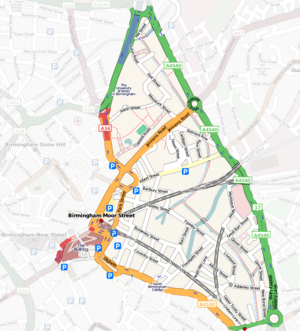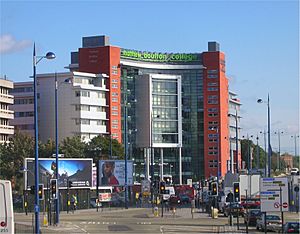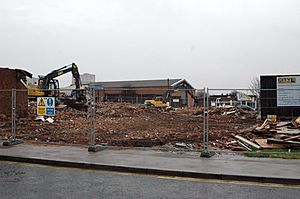Eastside, Birmingham facts for kids
Eastside is a special area in Birmingham City Centre, England. It's getting a huge makeover! This big project will cost billions of pounds. It will also create thousands of new jobs. Many jobs will appear during the building work. Even more jobs will be there when it's all finished. Eastside is a key part of Birmingham's bigger plan, called the Big City Plan.
Contents
History of Eastside
Long, long ago, in Medieval times, Eastside was mostly farmland. Digs have shown that the soil here was used for growing crops. A big part of this land was even bought by the English king. He used it as a special park for hunting deer.
Some of this deer park stretched into what is now Eastside. Today, only a small piece of it remains. This is known as Park Street Gardens. Over time, the land was sold off. It slowly went back to being farmland again.
Eastside in the Industrial Age
During the Industrial Revolution, Eastside became a busy place. It was full of factories and workshops. Canals helped move goods in and out. The Digbeth Branch Canal cuts right through the area. The Grand Union Canal is also nearby. These canals met at a place called Warwick Bar.
Later, in the late 1800s, trams ran along Albert Street. But as factories closed, the area became run-down. Old Victorian buildings were not looked after. The canals became dirty. Only small parts were ever cleaned up.
Some small, independent businesses moved in. There was a big brewery near Curzon Street station. This led to a pub opening nearby. That pub is still there today. It is a special old building.
Rivers and Railways
The River Rea also flows through the far east of Eastside. High brick walls built long ago hide most of the river. You can cross the river at Deritend Bridge.
Curzon Street railway station was very important in the 1800s. It was mainly used for moving goods. It was too far from the city centre for passengers. So, it closed down as a goods station in 1966.
Bartholomew Row got its name from Saint Bartholomew Church. This church was built right next to it. Park Street Gardens used to surround the church. But the gardens got much smaller as more buildings went up. Part of the church's old graveyard is still there.
In 1983, Aston Science Park opened in the north of Eastside. It is next to the Aston University campus. This park has grown a lot. It is a key part of the Eastside makeover plan.
Eastside's Big Makeover
Planning the Future
In the late 1990s, ideas for fixing up Eastside began. The first plan was in 1996. It focused on the area around Digbeth and parts of Eastside. Another plan in 1998 guided changes for Digbeth and Deritend.
Big projects started to be talked about. These included fixing, knocking down, and rebuilding parts of the area. The first big project finished was Millennium Point. It opened in 2002. It replaced the old Birmingham Science Museum. In 2002, a main plan for Eastside was made. It showed the basic ideas for new buildings.
In 2001, Eastside was divided into five smaller areas:
- Aston Triangle – This is the Aston University Campus.
- Curzon Street
- Fazeley Street
- Masshouse
- Rea Village
Building Begins
The first step of the plan started in 2002. A large raised road junction called Masshouse Circus was knocked down. This made space for new buildings. Masshouse Circus was part of the Inner Ring Road. This road had stopped the city centre from growing. Money from a European fund helped pay for the demolition.
Matthew Boulton College built a new main building in 2005. It looks over the Masshouse site. The New Technology Institute was finished in 2006. These were the first new buildings in a special "Learning and Leisure Zone."
Aston University also built new things on its campus. These included a new Academy of Life Sciences. There was also a big extension to Aston Business School. A huge project for student homes was also built. The campus kept its green spaces and trees. By 2007, the first people moved into new flats at Masshouse. An old building called Island House was fixed up. It became a base for a company working on the makeover.
Curzon Park Development
Most of the new building work is happening around Curzon Street railway station. This area is called Curzon Park. It started with knocking down a Parcelforce building.
Curzon Park will have many new buildings. These will include homes, fun places, and hotels. Plans for this big project were shared in 2007.
Eastside City Park
Next to Curzon Park, a huge city park is being built. It will cost about £11 million. This park will be called Eastside City Park. It will cover about 8 acres.
The area for the park used to be a car park for Millennium Point. Other buildings are also being knocked down. Los Canarios, Birmingham's first Spanish restaurant, was taken down in 2009 for the park. The new park will also include the old Park Street Gardens. This garden has a burial ground and was once part of a large deer park.
High Speed 2 Railway
Eastside is where the new High Speed 2 (HS2) train line will end. The new station will be called Birmingham Curzon Street. When HS2 is finished, train trips from London to Birmingham will be much faster. This could bring a lot of money and new businesses to the area.
Eastside Locks
Beyond the city park, towards the east, is an area called Eastside Locks. This will be a special park focused on technology. It will have many smaller buildings.
Other Projects in Eastside
Another area near Moor Street railway station was cleared when Masshouse Circus was removed. This area will be called City Park Gate. It will have homes and shops. Island House and a nearby pub will stay. But a large warehouse store was knocked down in 2006.
City Park Gate will mostly have homes. It will be a main entrance to Eastside from the city centre. The first part of building will start soon. It will also have green roof gardens.
In 2008, new student homes were built along Jennens Road. This tall building is near Aston University. It is also close to where Birmingham City University planned a new campus. The building is called Etna House. It is 13 floors high.
In 2008, Birmingham City University shared its plans for a new campus. It would be built across from Curzon Street station. The university bought the land in 2008. The first part of the building was planned to open in 2012. The Birmingham Conservatoire was expected to move there.
Projects That Didn't Happen
The city council once planned to put the Library of Birmingham in Eastside. But they decided to build it somewhere else. It was built with the Birmingham Repertory Theatre in Centenary Square. This kept the library in the city's main area.
Birmingham City University is now interested in the Eastside library site. They want to move their music school, the conservatoire, there. Another idea was to fix up the Curzon Street railway station entrance hall. It was going to be home to the Royal College of Organists. But they didn't have enough money. Now, the city council plans to fix the building themselves. Then they will look for someone to use it.
There was also an idea for a new train station in Eastside. It would help take pressure off New Street station. This new station was called "Grand Central Station." It would be almost twice as big as New Street. It would handle all major train lines. But this idea was dropped. People thought it was not needed and would take up too much space.
A tall observation tower was also planned for Eastside. It was called "VTP200." This tower would have been 200 metres tall. It was designed to be a bold new symbol for Birmingham. It would have had fun rides and activities. These included a free-falling lift and a sky jump. But this project was also cancelled.
Sustainable Eastside
"Sustainable Eastside – A Vision for the Future" was a plan made in 2002. It showed how Eastside could be rebuilt in a way that lasts. This means being good for people, the environment, and the economy. A group was also set up to help make Eastside sustainable.
The city council decided to have special advisors work with the Eastside team. These advisors help make sure new buildings and plans are sustainable. They are employed by Groundwork Birmingham and Solihull.
The "Sustainable Eastside" project gets money from different groups. These include the Government Office for the West Midlands. The project aims to show how sustainable development works. It also gives advice on the best ways to build sustainably.
The group has members from 17 different organisations. These include groups like the Wildlife Trust for Birmingham and the Black Country. In 2002, they wrote a document. It explained how Eastside could be successful and responsible.
The project keeps making new ideas for rules and plans. These ideas are given to Birmingham City Council. They help the council with its building guidance. They also help raise awareness about sustainability.
Arts and Culture in Eastside
Since 2006, Eastside has hosted many events for ArtsFest. In 2006, there was an Eastside Arts Picnic at Curzon Street Station. Island House showed many art pieces. Outside, there were colorful murals.
In 2007, a sound and light show was held at Curzon Park. Later in 2008, a new art gallery opened. It is called Eastside Projects. It shows art from local and international artists. The gallery is on Heath Mill Lane. It is now part of the biggest group of modern art places in the city. Other places include Ikon Eastside and Vivid.
A special sound guide was made for Warwick Bar. People could download sounds and walk around the canals.
Curzon Street Station is becoming a centre for arts in Eastside. It has hosted art shows. For example, a neon light show was held there in 2007. Also in Eastside are Ikon Eastside, a part of the Ikon Gallery, Eastside Projects, and VIVID.







